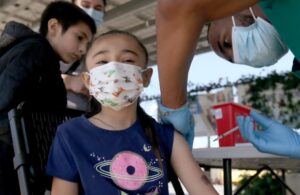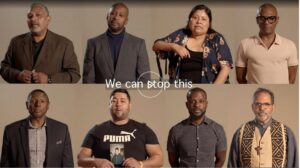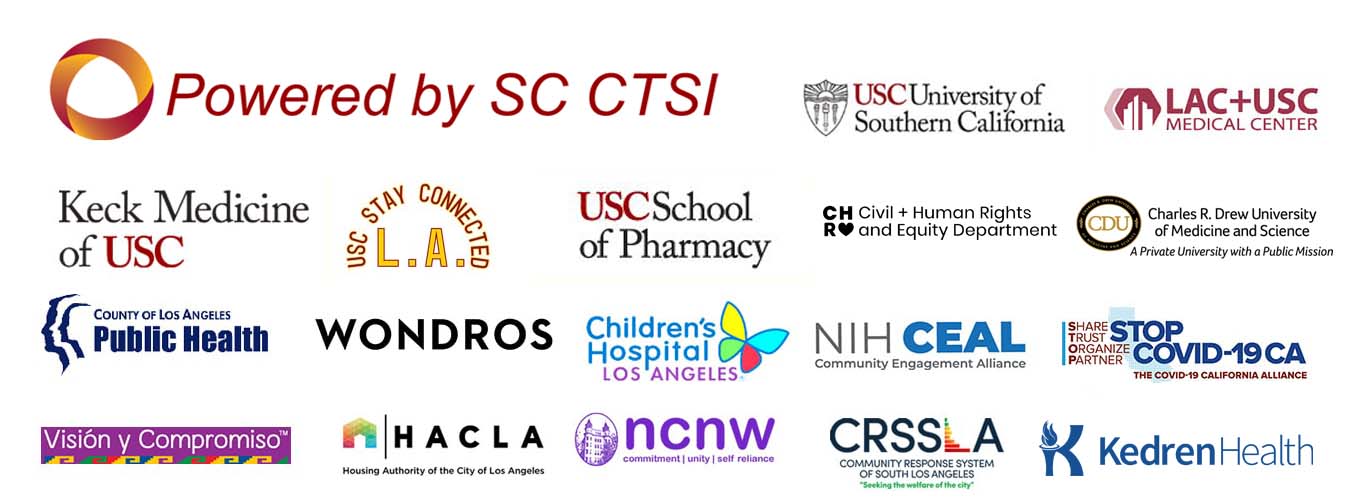As kids were spilling out of the gates at Helen Keller Elementary School in Lynwood, outreach worker Alma Aracen tried to talk to the parents crowded outside.
“We’re offering COVID vaccines,” Aracen said in Spanish to one mother, gesturing to the mobile clinic and tables set up by St. John’s Community Health near the school.
The woman, glancing over, replied in English, “Her daddy doesn’t want her to have it.”
In Los Angeles County, some parents jumped at the chance to get kids vaccinated when the shots first became available for them. But here and across the country, new immunizations for kids fell after an initial rush.
Only 30% of children ages 5 to 11 were fully vaccinated in L.A. County as of mid-March, compared with nearly 80% of teens and adults — a gap that echoes the national trend. The numbers have stagnated across the country even after children were newly hospitalized with COVID-19 at record rates during the Omicron wave, according to federal data.
More than a third of parents surveyed nationally by the Kaiser Family Foundation in February said they would definitely not get their children ages 5 to 11 vaccinated — roughly the same number who said they already had done so. A shrinking share of parents, over time, have said they plan to do so “right away.”
Others said they would “wait and see,” or get the shots for their kids only if it was required.
Health officials and researchers are still examining the reasons why parents are not getting the shots for the youngest kids who are eligible. Black and Latino children, who make up the majority of kids in Lynwood, are much less likely to be vaccinated than white and Asian American children in L.A. County.
Vaccination rates among kids are also lower in many of the poorest parts of the county — a possible reflection of problems with access. But even in some affluent areas such as Beverly Hills and Marina del Rey, the majority of young children aren’t vaccinated.
In Hermosa Beach, Erica Meyrich-Pinciss decided against vaccinating her 6-year-old son, who has a rare genetic disorder affecting his cellular growth. Among her concerns was that “there’s no way that they would have included someone like my son in the testing” of the COVID-19 vaccine, she said.
She and her husband have gotten vaccinated, but “I weighed the benefits and risks, and I just felt that … this was not the right thing for him specifically,” said Meyrich-Pinciss, a former market researcher.
Across the county in the L.A. neighborhood of Virgil Village, Justine Gonzalez concluded that getting vaccinated was the best way to protect her 8-year-old from persistent effects from a COVID-19 infection.
Most children may not end up in the hospital from the coronavirus, but “I don’t know what COVID will do to a child over the years,” said Gonzalez, who works in educational advocacy. Even if the effectiveness of the vaccine wanes with time, “I’d much rather take that chance than take the chance of what COVID could do.”
For many parents, the decision comes down to their beliefs about how severe COVID-19 would be for their child. State data compiled by the American Academy of Pediatrics show that between 0.1% and 1.5% of childhood cases of COVID-19 resulted in hospitalization and up to 0.01% led to death.
Many parents say “‘I’d rather not take the risk of vaccinating my kid if we just get a cold,’” said Dr. Paul Han, assistant chief of pediatrics at Kaiser Permanente Los Angeles Medical Center. But “I’ve seen the unvaccinated kids coming in, needing oxygen support, needing to be on a ventilator. I’ve seen unvaccinated kids die from complications of COVID.”
With huge increases in youth cases during the Omicron surge, the U.S. was averaging more than 900 children and teens being newly hospitalized with COVID-19 per day during a peak week in January, according to federal data. There have been 167 COVID-19 deaths reported among children ages 5 to 11 since the pandemic began, according to the CDC.
Han said he stresses to parents that the vaccine is safe and highly effective in protecting kids against severe illness and hospitalization. Even if a COVID infection is initially mild, he added, it can lead to later ramifications such as multisystem inflammatory syndrome.
But after hearing early in the pandemic that kids were at lower risk, “mothers especially clung to that message,” said Jessica Calarco, an associate professor of sociology at Indiana University who has studied decision-making among mothers. “It meant they could give themselves permission to send their kids back to school, to send their kids back to in-person child care.”
Calarco said many of those same parents started to ignore any news about COVID and children that would shake that sense of calm, which created a self-perpetuating cycle.
Then came parental anxieties about the effects of the vaccine: In a national survey that Calarco and a colleague undertook, less than half of U.S. parents who were surveyed said that COVID was a bigger threat to their children than the COVID vaccines.
In Westchester, Marie Elena Rigo said that when she looked at the statistics, she concluded that her two “vibrant, healthy, fit children” were not at risk. That belief was reinforced by the fact that both had been exposed to COVID and one of them tested positive, but had only a mild case, she said.
“If my kid had a comorbidity or was at risk, that might be a different story. But I just didn’t see the need,” said Rigo, an executive coach whose children are ages 8 and 11. She also worried about the risk to her son of myocarditis — inflammation of the heart muscle — from the shots.
The U.S. Centers for Disease Control and Prevention has continued to recommend vaccination for everyone ages 5 or older, stating that the known risks of COVID far outweigh the possible risks of myocarditis or other adverse reactions.
Among millions of kids who have gotten vaccinated, the rate of myocarditis among those ages 5 to 11 has been under one in a million, said Dr. Yvonne Maldonado, an infectious-disease epidemiologist at Stanford University. “We know that the risk for hospitalization for kids — for any cause related to COVID — is much higher than that.”
Many children who have been hospitalized have not had any underlying conditions, she added.
In Eagle Rock, cognitive scientist Carmel Levitan said she had concluded that “the vaccine is almost zero risk for kids at this age,” but that even a mild case of COVID-19 could lead to longer-term effects on the heart or brain. She got her 7-year-old and 10-year-old their first shots soon after they became available.
“I don’t want any of us to be getting signs of dementia 10 years earlier than we would have,” said Levitan, who has studied brain imaging studies from the United Kingdom with concern.
At the Southern California Clinical and Translational Science Institute at USC, researchers talked to parents in South L.A. and East L.A. and found that many had safety concerns about the vaccines.
That included many parents who had gotten their older children vaccinated against COVID, indicating that health messaging needs to be targeted to concerns about younger kids, said Nicole Wolfe, associate director of community engagement for the institute. Location also mattered: Some said they would rather get their child vaccinated at a doctor’s office than other sites.
“When parents are thinking about vaccinating their child, they really want to talk to trusted sources of information” like their pediatrician, said Dr. Nava Yeganeh, medical director of vaccine preventable disease control at the L.A. County Department of Public Health.
Yeganeh said health officials want the COVID-19 vaccines to be available alongside the usual immunizations that children get during their scheduled visits to a pediatrician. And “we’re making sure that parents are aware of the information about how incredibly safe these vaccines are,” she said.
In Hawthorne, Brittania Hurst is vaccinated against COVID but has hesitated to get the shots for her 10-year-old son, who has a heart condition. COVID and its threat are very real to her — “I can’t tell you how many relatives and friends that I’ve buried,” Hurst said.
But “you can’t just rush to make a quick decision that could potentially affect the rest of his life,” said Hurst, who works as a driver for a car service for kids. Her pediatrician encouraged her to get her son vaccinated, but didn’t push her.
“I would have been completely turned off if they had been pushy,” Hurst said.
The L.A. County public health department has also trained “parent ambassadors” who then share information with friends, family and others in their communities. Among them is Luana Enriquez, who lives near West Covina and works for the county public works department.
When people asked her about the vaccine, “I wanted to be able to give them facts versus fiction,” Enriquez said. “A lot of people are playing on fear and false information.” With some of her friends who oppose vaccination, “it’s almost political. So I share things — not to shove it down their throat, but give them the information.”
In some parts of L.A. County, kids are overwhelmingly vaccinated: In the oceanfront enclaves of Rancho Palos Verdes and Palos Verdes Estates, at least 95% of children ages 5 to 11 are estimated to be fully vaccinated. In the affluent cities of San Marino and South Pasadena, the percentages were around 90% as of mid-March.
Sandra Chen Lau, whose children attend school in San Marino, said her sister-in-law is a pulmonologist who had advised that getting the kids vaccinated would help protect them against serious and long-term illness.
“I felt that if our kids were going to be around grandparents, around other family members, they needed to be vaccinated,” said Chen Lau, a film institute executive whose family lives in Pasadena. She also felt it was important for them to be back in school, and “the more vaccinations there were, as kids in school, the safer everybody would be.”
As of mid-March, L.A. County data showed that 59% of Asian American children ages 5 to 11 had gotten at least one COVID shot, compared with 41% of white children, 22% of Latino children and nearly 21% of Black children. In areas such as South Gate and Lynwood, where the vast majority of kids are Latino, vaccination rates for young children have fallen below the county average.
As her team canvassed local businesses in Montebello, Rosa Vazquez said messages about vaccines abound on social media and television but have failed to land with many people who felt their communities were “left out in the cold” during the pandemic.
“They felt that the systems that were supposed to protect them … didn’t do what they were supposed to do. And now these same systems are telling them, ‘Get this vaccine that is going to fix everything,’” said Vazquez, leader of the Los Angeles-area team for the ¡Ándale! ¿Qué Esperas? vaccine outreach campaign launched by AltaMed Health Services in partnership with community health centers.
“The government is just saying, ‘Vaccines, vaccines, vaccines.’ And what they’re saying is, ‘We need to pay rent. Why are you not listening?’”
Vazquez said her team retooled in January to focus on community concerns rather than putting vaccination at the forefront. “We say, ‘We’re a community campaign. … How did the pandemic impact you?”
Their campaign brings out rapid tests to apartment complexes and schools, provides information about vaccines and vaccination events, and builds ties to local businesses where they share fliers about food banks and affordable clinics. Its young workers come from many of the same areas where they do outreach.
“I let them know I’m from around here,” said Óscar Macías, an intern with the team whose roots are in East Los Angeles. “If you connect with them, they’re more willing to talk.”
In South Gate, the team set up a table outside KIPP Corazón Academy Lower School with a cover displaying the name of their campaign, which translates roughly to “Come on! What are you waiting for?” As parents lined up outside the school to pick up their kids, AltaMed intern Cristina Mares handed out fliers for an upcoming event where vaccines would be available.
“We also have free COVID tests,” Mares told one woman in Spanish.
“Free?” the woman replied.
Soon parents began to approach the table where rapid tests, bottles of sanitizer, buttons and fliers about booster shots were set out. Macías, equipped with an electronic tablet, took down their names and other information for testing kits. Vazquez, watching the buzz around the table, said they had the most success “when we led with services.”
“If vaccines continue to be the message,” Vazquez said, “we’re going to lose these communities.”
Times staff writer Rong-Gong Lin II contributed to this report.
Photo by Luis Sinco / Los Angeles Times



